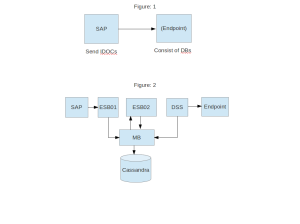Enterprise integration with WSO2 ESB + WSO2 MB and WSO2 DSS in a production environment with guaranteed delivery
Requirement
Customer has a SAP system from which he wants to send IDOCs to their respective endpoints and at the end of the day endpoints will send reports to the SAP system back. Here is the architecture of the deployment which customer is going to deploy in his production environment.
Basically customer want to send the information in the SAP system to the BE databases in a reliable and efficient manner without interacting in between.
Solution
In this solution we have used the following resources to achieve the requirement.
02 WSO2 Enterprise Service Bus
01 WSO2 Data Services Server
01 WSO2 Message Broker
Functionality
ESB01 – This ESB receives the IDOC message from the SAP server and save those documents in the WSO2 MB using message queues. Here we handle the high load of messages by saving them to the Cassandra data base which is installed in a separate server. This will ensure that the high load of incoming messages are saved in the message queues without loosing any of the message.
ESB02 – This ESB consumes the saved messages from the message queues and apply the required transformation like changes and save the messages in a different set of queues. This will guarantee that the server is performing the transformations without bothering about receiving and saving the messages in the queues.
Message Broker – This will save the messages when they are receiving as a high load and guarantee that every message is successfully saved within the Cassandra database.
Data Services Server – This will push the messages from the message queues and load them back to the databases in the BE servers of the user. This will ensure that the every message saved in the message queues are automatically picked up by the data service and load them back to the databases in the BE.
Advantages
This setup will ensure that the messages are delivered without loosing any data in any kind of high load scenario (Guaranteed Delivery)
Isolation of the operation to different servers make it easy to maintain different parts of the operation.

Have the detail setting and scripts?
ReplyDeleteYou can find the settings and scripts from here http://soatutorials.blogspot.com/2013/09/building-in-order-reliable-messaging.html
ReplyDelete